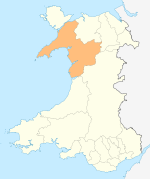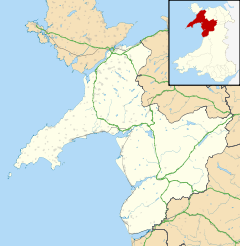- Nefyn
-
Coordinates: 52°56′06″N 4°31′30″W / 52.93503°N 4.52499°W
Nefyn
A view over Nefyn
 Nefyn shown within Gwynedd
Nefyn shown within GwyneddPopulation 2,619 (2001) OS grid reference SH304405 Community Nefyn Principal area Gwynedd Ceremonial county Gwynedd Country Wales Sovereign state United Kingdom Post town PWLLHELI Postcode district LL53 Dialling code 01758 Police North Wales Fire North Wales Ambulance Welsh EU Parliament Wales UK Parliament Caernarfon Welsh Assembly Dwyfor Meirionnydd List of places: UK • Wales • Gwynedd Nefyn is a small town and community on the north west coast of the Llŷn Peninsula in Gwynedd, Wales, with a population of 2,619.[1] Welsh is the first language of almost 80% of its inhabitants. The A497 road terminates in the town centre.
Contents
History
The history of the area can be traced back to 300BC with the Iron Age hillfort of Garn Boduan overlooking Nefyn. The remains of 170 round stone huts and ramparts are still visible on top of the 917 feet (280 m) hill.
The earliest known reference to Nefyn in documents dates from the latter part of the 11th century, where it is mentioned as a landing place of the Welsh prince, Gruffydd ap Cynan.[2]
Gerald of Wales writing in his account of a journey around Wales in 1188 states he slept at Nefyn on the eve of Palm Sunday.
The town was the place of a jousting tournament held by Edward I of England in 1284 to celebrate his victory over the Welsh, emphasising its importance at that time as a trading town. In 1355 it became a free borough and remained an important centre of commerce.
The sea was always an important part of the economy of Nefyn and fishing, particularly for herring, became the prime trade for most of the 18th and 19th centuries: so much so that the town's coat of arms bears three herrings.
Parish church and origin of the name Nefyn
The foundations of the old St Mary's parish church date from the 6th century, although the present building was erected in 1827. It would have been an important staging post for pilgrimages to Ynys Enlli (Bardsey Island). The church is no longer a place of worship but houses a museum dedicated to the maritime history of Nefyn.
The name Nefyn is the Welsh cognate of the Gaelic Goddess Nebhain. Indicative of the settlement of the Llŷn Peninsula (In Irish Laighin, the same derivation as Leinster) in the 4th or 5th century by Irish tribes. The Romans recorded a tribe occupying the peninsula called the 'Gangani', who are also recorded as a tribe in Ireland. 'Nevin' as an Irish female name means 'worshipper of the saint'. Nefyn is another form of Nyfain, an early Welsh female saint.
20th century and after
During World War II, the Royal Air Force built a Chain Home radar station to the south-west of Nefyn.
A tremor in the area on 12 December 1940 was reported by the Cambrian News as having caused two fatalities including John Thomas of Nefyn who died of a heart attack.[3]
On 19 July 1984 an earthquake measuring 5.4 on the Richter scale had an epicentre near Nefyn. This is one of the strongest tremors recorded in the UK for recent times but caused little structural damage.
It is twinned with Puerto Madryn, a town in Chubut Province in Argentina (see Welsh settlement in Argentina).
Notable people
- Harpist John Parry (ca. 1710 - 1782) known as Parry Ddall Rhiwabon or Blind Parry of Rhiwabon was born in Nefyn ca. 1710.
- Sir Thomas Duncombe Love Jones-Parry (1832–1891) 1st Baronet, Liberal Member of Parliament and one of the founders of the Welsh settlement in Argentina, inherited the Madryn estate near Nefyn in 1853.
- Elizabeth Watkin-Jones (1887–1966), author of children's books in the Welsh language was born in Nefyn on 13 July 1887.[4]
- Actor Rupert Davies (1916–1976), who played Maigret in the eponymous BBC television series in the sixties, is buried at Pistyll near Nefyn.
- Singer Duffy was raised in Nefyn.[5]
References
- ^ Office for National Statistics : Census 2001 : Neighbourhood Statistics : Parish Headcounts : Gwynedd
- ^ Roland Bond (2008). Nefyn: The story of an ancient Gwynedd town and parish. Gwasg Carreg Gwalch. ISBN 978-1-84524-124-7.
- ^ Musson, RMW (2003) Fatalities in British earthquakes, in: Astronomy & Geophysics; 44 (1), 1.14–1.16. doi:10.1046/j.1468-4004.2003.44114.x"1468-4004.2003.44114.x". http://www.blackwell-synergy.com/doi/pdf/10.1046/j.1468-4004.2003.44114.x.
- ^ Llyfrgell Genedlaethol Cymru. "Elizabeth Watkin-Jones". http://yba.llgc.org.uk/en/s2-WATK-ELI-1887.html. Retrieved 2009-05-29.
- ^ Radio Times interview, 22 November 2008
Population and Language Statistics - 2001 Census [1]
External links
 Media related to Nefyn at Wikimedia Commons
Media related to Nefyn at Wikimedia Commons- Former Nefyn resident's relatives in America
- Herring fishing at Nefyn
- Nefyn.com - This site contains stories and photos from a former Nefyn resident.
- The Last Great Nefyn Herring Catch 1950
- Draw Netting in Nefyn 1954
- An Evacuee's Story: From Kent to North Wales
- Shipbuilding in Nefyn
- Further archival information on Nefyn
- Flikr Search for Nefyn Photographs
- Panoramio Search for Nefyn Photographs
- - Online guide to the Llŷn Peninsula
- www.geograph.co.uk : photos of Nefyn and surrounding area
- British Geological Survey case study of landslide in Nefyn in 2001
Gwynedd Principal settlements Bala • Bangor • Barmouth • Bethesda • Blaenau Ffestiniog • Caernarfon • Criccieth • Dolgellau • Ffestiniog • Harlech • Nefyn • Porthmadog • Pwllheli • Tywyn
Towns and villages Aberangell • Aberdaron • Aberdesach • Aberdyfi • Abererch • Abergeirw • Abergwyngregyn • Abergynolwyn • Aberllefenni • Abersoch • Abertrinant • Afon Wen • Anelog • Arthog • Beddgelert • Bethania • Bethel • Bethesda • Betws Garmon • Bodferin • Boduan • Bontddu • Bontnewydd • Botwnnog • Bryncroes • Bryn-crug • Brynrefail • Buan • Bwlch-derwin • Caeathro • Capel Celyn • Carmel • Carnguwch • Ceidio • Chwilog • Clwt-y-bont • Clynnog Fawr • Corris Uchaf • Corris • Croesor • Cwm y Glo • Deiniolen • Dinas • Dinas Dinlle • Dinas Mawddwy • Dinorwig • Dolbenmaen • Dolmelinllyn • Dwygyfylchi • Edern • Efailnewydd • Eisingrug • Fairbourne • Friog • Frongoch • Ganllwyd • Garndolbenmaen • Garneddwen • Gellilydan • Glasinfryn • Groeslon • Llan Ffestiniog • Llanaber • Llanaelhaearn • Llanarmon • Llanbedr • Llanbedrog • Llanberis • Llandanwg • Llandegwning • Llandeiniolen • Llandudwen • Llandwrog • Llandygai • Llanegryn • Llanelltyd • Llanengan • Llanfaelrhys • Llanfaglan • Llanfair • Llanfihangel Bachellaeth • Llanfihangel-y-Pennant • Llanfihangel-y-Pennant, Dolbenmaen • Llanfrothen • Llangelynnin • Llangian • Llangwnnadl • Llangybi • Llaniestyn • Llanigian • Llanllechid • Llanllyfni • Llannor • Llanrug • Llanuwchllyn • Llanwnda • Llanymawddwy • Llanystumdwy • Llithfaen • Llwyndyrys • Llwyngwril • Maentwrog • Mallwyd • Mellteyrn • Minffordd • Morfa Bychan • Morfa Nefyn • Mynydd Llandygai • Mynydd Nefyn • Mynytho • Nantlle Valley • Rhostryfan • Nantmor • Nasareth • Nebo • Pant Glas • Penffridd • Penisa'r Waun • Penllech • Penllyn • Penmaenpool • Pennal • Penrhos • Penrhyndeudraeth • Pentre Gwynfryn • Penygroes • Pen-y-meinl • Pistyll • Pontrug • Porthdinllaen • Portmeirion • Prenteg • Rachub • Rhiwddolion • Rhosgadfan • Rhoshirwaun • Rhoslefair • Rhos-y-gwaliau • Rhyd Ddu • Rhyd • Rhydyclafdy • Sarn Meyllteyrn • Soar • Talsarnau • Tal-y-bont (near Bangor) • Tal-y-bont (near Barmouth) • Talysarn • Tanygrisiau • Trawsfynydd • Trefor • Tregarth • Tremadog • Tudweiliog • Tywyn • Waunfawr • Y Felinheli • Y Ffor • Y Fron • Y RhiwUniversities and colleges Castles and forts Rivers Afon Artro • Afon Cwmnantcol • Afon Dwyryd • Afon Dysynni • Afon Fathew • Afon Glaslyn • Afon Llyfni • Afon Mawddach • Afon Rhythallt • Afon Seiont • Afon TrywerynIslands Categories:- Seaside resorts in Wales
- Towns in Gwynedd
Wikimedia Foundation. 2010.


